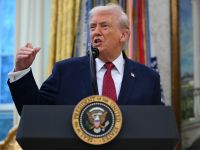Tunisia, the Maghreb's smallest country, has one of the region's healthiest economies. Since 1997, the country's GDP has expanded by about 5.6 percent annually, an outstanding rate compared to its neighbors. Inflation has been held below 4.0 percent.
One of the main strengths of the economy is its diversity. The service sector (primarily tourism) comprises roughly 34 percent of GDP, manufacturing industries, 17.8 percent, agriculture, 11 percent, and non-manufacturing industries, primarily phosphate mining and hydrocarbons, which contribute about 4.5 percent of GDP.
Tourism and textile production are the two sectors earning the highest revenue. The latter totals about $800 million and comprises roughly 33 percent of the manufacturing sector.
The country has recently entered into a Free Trade Accord with the EU under which it will remove tariff and other trade barriers on most non-agricultural goods, services and capital by 2008.
The road to this country's economic success began in 1986 when the country turned from its socialist past and sought guidance from the IMF and World Bank.
Tunisia simplified its tax system and reduced tax rates, with a fixed maximum rate of 35 percent for businesses. Banking and financial sectors were partly liberalized and restructured. Some public companies were privatized and foreign trade and domestic prices de-controlled. As of 1997, 87 percent of prices were deregulated at the production level and 85 percent at the distribution level. Also, 97 percent of imports no longer require prior licensing. Maximum tariff rates on a broad range of imports, however, rose from 43 to 287 percent in July 1996.
All of these measures have made their impression felt on the population. According to Tunisian government statistics, more than 60 percent of the population is middle class. Only 6.7 percent falls below the poverty threshold. The national savings rate is 23 percent and 79 percent of Tunisians own their own homes. Over 85 percent of Tunisian homes are connected to the electrical grid, and 70 percent have potable water.
In July 1999, the IMF predicted that Tunisia’s GDP would have real growth of 6.5 percent with inflation holding at 3 percent. Its economy was helped by good harvests and a large diversion of Mediterranean tourists to Tunisia because of the war in the Balkan and security concerns in Turkey.
Tourism is crucial to the country's economy. During the first 9 months of 1999, the number of arriving tourists rose 16.7 percent to 4.63 million and the level of European tourists increased by 16.1 percent. This is significant because tourism is the country’s main source of foreign exchange revenues. Through November1999, the country’s foreign exchange earnings from tourism totaled TD 1.82 billion, which is greater than all of 1998's figures of TD 1.71 billion
The country's current account deficit is projected to reach 3.7 percent of GDP compared with 3.4 percent in 1998. Fiscal revenues increased by 0.5 percent of GDP despite a removal of trade tariffs. Debt service declined by 0.4 percent of GDP and privatization receipts rose to 1.8 percent of GDP in 1998.
Tunisia's trade volume with its African and Arab neighbors increased 6.5 percent in 1998 to TD 1.042 billion. Its trade deficit with these countries was TD 56.8 million down from 129.8 million in 1997. Exports to sub-Sahara Africa jumped by 27 percent and recorded an 11.5 percent increase with Gulf countries.
Investment intentions in Tunisia’s industry sector in 1998 rose 15.9 percent to TD 1.166 billion ($988.1 million) from TD 1.006 billion. This leap was spurred primarily by increased investment in the building sector which rose 64.4 percent to TD 193 million from TD 117 million and in the mechanical and electrical sector which leaped 59.3 percent to TD 170 million.
Intentions of investment in the chemical sector declined 21.2 percent to TD 97 million from TD 123 million. Intentions of investment with the participation of foreigners totaled TD 383 million, down 13.7 percent from TD 444 million. Intentions of investment in services were down 50.3 percent to TD 291 million from TD 584 million.
The country, which is a World Trade Organization member, is most interested in foreign investment that boosts export earnings, attracts technology, creates rather than cuts jobs and minimally competes with domestic industry.
Unemployment is one of the country's most serious problems at more than 25 percent. President Ben Ali called job creation ''the priority of priorities.'' By January 2000, the ''National Employment Fund'' may start its activities. This program was announced last October and is part of a multi-initiative to develop employment opportunities.
The government has also launched the ''mise a niveau'' program, which was designed to raise productivity of Tunisian business during the next 10 years to allow them to be able to better compete on the global level. This will take on added importance when the service sector is opened to foreign competition in 2001 under WTO and EU FTA agreements. The other goal of the ''mise a niveau'' program is to improve the country's infrastructure, communications and other trade-and-investment related capabilities.
The European Investment Bank (EIB) is helping in this endeavor, lending its North African neighbor 83.1 million Euros to finance public and private sector projects. Besides this, the government issued in August 1999 its first Eurobond, raising 225 million Euros.
Economic Figures
2000 1999 1998 1997
GDP Growth (percent) 6.0(T) 6.2 5.0 5.4
Exports (TDbn) 6.370* 6,532 6,148
Imports (TDbn) 9.182* 9,476 8,794
Inflation 2.7 3.1 3.7
Tourism Earnings (TD bn) 1.82* 1.71 1.55
Remittances (in cash and TD mn) 683* 654 616
Foreign Direct Investment (including energy) (TD mn) 277.5** 760 406
Current Account Balance (TD mn)-222.8 -769 -655
Unemployment*** 15.2 15.4
Expenditure (budgeted TD bn)10.510 9.590 8.726 -
Revenues (budgeted TD bn) 6.580 6.185 5.175 -
Government Net Deficit (excluding debt amortization) (budgeted TD bn) -0.750 (T) 0.910 (E) - -
Deficit as % GDP 2.7 (T) 3.6 (E) - -
(T) = target
(E) = estimate
*Through November 1999
**Through September 1999
***Provisional
Government Role in the Economy
The government has been slowly stepping back from the economy and encouraging the private sector to assume a greater role. Still, the government's role in the economy is greater than that of other countries at comparable levels of development.
While the government has had a cautious privatization program, it does face some important obstacles such as fears of mass firing in massive layoffs in unprofitable and overstaffed public companies.
The government of Tunisia has been methodically reducing its role in the economy. Although the privatization program is supported by the National Labor Federation (UGTT), the government is moving carefully to avoid mass firings in unprofitable public companies.
The government is focusing on the stock market as the principal vehicle for the privatization program. Specific targets are companies operating in competitive sectors.
The most dramatic re-orientation has occurred in the financial and banking sectors. The Central Bank is gradually shifting to a supervisory and regulatory role. Interest rates were officially deregulated and commercial banks allowed to move into the long term credit market. The government made the Tunisian Dinar convertible for current account transactions, and currency trading was privatized.
In the financial markets, the former state-controlled stock exchange, the Bourse, was privatized. The new structure is composed of brokerage houses. Similarly, a privately held central stock clearing house company was established. The state will continue to exercise its supervisory and regulatory role through the Financial Market Council.
Reforms Policy
Tunisia, under the influence of president Ben Ali, has implemented an International Monetary Fund-style economic stabilization program, highlighted by rigorous budget balancing, foreign trade liberalization and private sector incentives. Consequently, economic growth rates have surged.
Most of this capital came from European Union investors who were encouraged by Tunisia's proximity to southern Mediterranean markets, relatively low cost labor force and enhanced fiscal transparency.
If there are any gathering storm clouds on the Tunisian horizon, they are probably in the area of nascent privatization, where turf conscious Tunisian bureaucrats frequently erect obstacles for local businessmen. Barriers, however, are slowly falling (particularly in the area of agriculture), and all signs now point towards considerably higher levels of both local and foreign investment and sustainable overall economic growth.
© 2000 Mena Report (www.menareport.com)







